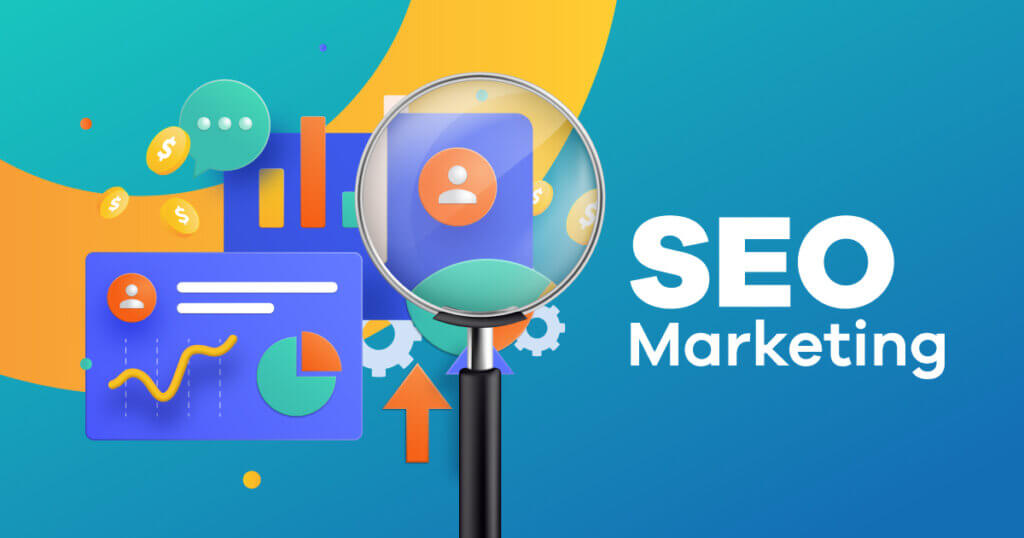SEO Marketing
Search engine optimization (SEO) marketing is optimizing your website to rank higher in search engine results pages (SERPs) for specific keywords and phrases. Optimizing your website for search engines increases your visibility online, drives more traffic to your website, and ultimately increases sales and revenue. This article will cover the basics of SEO marketing, why it’s essential, and how it works.
What is SEO Marketing?
SEO marketing is optimizing your website to rank higher in search engine results in pages for specific keywords and phrases. When someone searches for a particular keyword or phrase in a search engine like Google, the search engine returns a list of results that are relevant to that keyword or phrase. Optimizing your website for specific keywords can increase your chances of appearing in the top search results for those keywords, leading to more traffic and revenue for your website.
Why is SEO Marketing Important?
SEO marketing is essential for several reasons:
- Increased visibility: When you optimize your website for search engines, you increase your visibility online. This means that more people will be able to find your website when they search for relevant keywords.
- More traffic: By appearing higher in search engine results pages, you’ll attract more clicks to your website. This can lead to more traffic, leading to more sales and revenue.
- Better user experience: When you optimize your website for search engines, you’re also improving the user experience of your website. This can lead to more engagement, longer on-site time, and, ultimately, more conversions.
How Does SEO Marketing Work?
SEO marketing involves several different SEO marketing strategies and techniques designed to help your website rank higher in search engine results pages. Some of the critical components of SEO marketing include:
- On-page SEO refers to optimizing your website’s content and HTML source code. This includes title tags, meta descriptions, header tags, keyword optimization, content creation, and internal linking.
- Off-page SEO refers to optimizing external factors that can impact your website’s ranking in search engine results pages. This includes link building, social media marketing, influencer outreach, and brand mentions.
- Technical SEO: Technical SEO refers to the optimization of the technical aspects of your website that can impact your search engine rankings. This includes site architecture, speed, mobile optimization, and structured data.
- Local SEO: Local SEO is optimizing your website for local search results. This includes Google My Business, local directories, online reviews, and local content.
- Analytics and Reporting: Analytics and reporting are essential components of SEO marketing. This involves tracking your website’s performance using tools like Google Analytics and Search Console, as well as other tracking tools. You can use this data to optimize your website and improve your search engine rankings.
- SEO Strategy and Planning: Finally, SEO marketing involves developing and implementing a strategic plan to optimize your website for search engines. This includes keyword research, competitive analysis, content planning, on-page optimization, link-building, and reporting and analysis planning.
Conclusion
In conclusion, SEO marketing is essential for businesses that want to increase their visibility online, drive more traffic to their website, and, ultimately, increase sales and revenue. Optimizing your website for search engines using on-page, off-page, technical, local, analytics, and reporting strategies can improve your search engine rankings and attract more visitors. With the right SEO strategy and planning in place, you can achieve long-term.
On-Page SEO
On-page SEO is optimizing individual web pages on your website to rank higher in search engine results pages (SERPs) and earn more traffic. It involves optimizing your pages’ content and HTML source code to make them more search-engine friendly. This article will cover the critical components of on-page SEO and how they can help your website rank higher in search engines.
Title Tags
Title tags are one of the most important on-page SEO factors. They appear in the search engine results pages as the clickable headline for a given result. The title tag should be unique and accurately describe the content on the page. It should also include the primary keyword or phrase for that page, as this will help search engines understand what the page is about.
Meta Descriptions
Meta descriptions are the summaries that appear under the title tag on search engine results pages. While they do not directly impact rankings, they can significantly impact click-through rates. The meta description should be compelling and accurately describe the content on the page. It should also include the primary keyword or phrase for that page.
Header Tags
Header tags are HTML tags used to differentiate your content’s various headings and subheadings. They help organize your content and make it easier for users and search engines to read. Header tags range from H1 (the page’s main heading) to H6 (subheadings within the content). It’s essential to use header tags logically and hierarchically, with H1 tags reserved for the main title and subsequent tags used for subheadings.
Keyword Optimization
Keyword optimization involves using relevant keywords and phrases throughout your content to help search engines understand what your page is about. Using keywords naturally and appropriately is essential to avoid overstuffing your content with keywords. Keyword research can help you identify your pages’ most pertinent and high-traffic keywords.
Content Creation
Content creation is a critical component of on-page SEO. High-quality and engaging content can help to attract more traffic to your website and earn more backlinks from other sites. When creating content, it’s essential to use relevant keywords and phrases, and header tags to organize it. It would help if you also aimed to create unique, informative, and valuable content for your target audience.
Internal Linking
Internal linking involves linking to other pages on your website from within your content. This helps create a better user experience by allowing users to navigate easily related pages on your website. It also helps distribute link equity throughout your website, improving your overall search engine rankings. When linking internally, it’s essential to use relevant anchor text and to connect to a page related to the content.
Conclusion
In conclusion, on-page SEO is essential to any successful SEO strategy. Optimizing your title tags, meta descriptions, header tags, keywords, content, and internal links can make your website more search engine friendly and attract more traffic. While on-page SEO is just one component of a comprehensive SEO strategy, it is an important one that can significantly impact your search engine rankings and overall online visibility.
Off-Page SEO
Off-page SEO refers to the activities conducted outside of your website to improve your search engine rankings and increase the visibility of your website. In other words, it is improving your website’s reputation and authority through external means. This article will cover the critical components of off-page SEO and how they can help your website rank higher in search engines.
Backlinks
Backlinks are links that are directed to your website from other websites. They are one of the most important factors that search engines use to determine the authority and relevance of your website. The more high-quality backlinks your website has, the more likely it is to rank higher in page search engine results. However, it’s important to note that not all backlinks are created equal. Focusing on getting high-quality backlinks from reputable and relevant websites is essential.
Social Media Marketing
Social media marketing is another essential component of off-page SEO. Social media platforms such as Facebook, Twitter, and Instagram can help promote your website and attract more visitors. Creating engaging content and sharing it on social media can increase your brand awareness and attract more followers. This, in turn, can lead to more website traffic and backlinks.
Guest Blogging
Guest blogging involves writing articles for other websites in your niche in exchange for a link to your website. This is a great way to attract high-quality backlinks and improve your website’s reputation and authority. However, it’s essential to focus on writing high-quality, informative, and relevant content that will be useful to the readers of the website you are guest blogging for.
Online Directories
Online directories list businesses and websites in specific niches or industries. You can attract traffic and backlinks by listing your website in relevant directories. However, it’s essential to focus on high-quality guides that are reputable and pertinent to your niche. Listing your website in low-quality directories can hurt your search engine rankings.
Influencer Marketing
Influencer marketing involves partnering with influencers in your industry or niche to promote your website or products. Influencers have large social media followings and can help you to increase your brand awareness and attract more website traffic. However, choosing influencers who are relevant to your niche and genuinely interested in your brand is essential.
Conclusion
In conclusion, off-page SEO is essential to any successful SEO strategy. By getting high-quality backlinks, engaging in social media marketing, guest blogging, listing your website in relevant directories, and partnering with influencers, you can improve your website’s reputation and authority and attract more traffic. While off-page SEO is just one component of a comprehensive SEO strategy, it is an important one that can significantly impact your search engine rankings and overall online visibility.
Technical SEO
Technical SEO refers to the technical elements of a website that impact its search engine rankings. It involves optimizing the website’s backend and infrastructure to improve its visibility to search engines. This article will cover the key components of technical SEO and how they can help your website rank higher in search engines.
Website Speed
Website speed is a critical factor in technical SEO. A slow-loading website can negatively impact the user experience, hurting search engine rankings. Therefore, optimizing your website’s loading speed by compressing images, minimizing code, and reducing the number of HTTP requests is essential.
Mobile Optimization
Mobile optimization is another critical component of technical SEO. With more and more people accessing the internet on mobile devices, websites must be optimized for mobile viewing. This includes using responsive design, optimizing images for mobile viewing, and ensuring that the website is mobile-friendly.
Website Security
Website security is also a crucial component of technical SEO. Search engines prioritize websites that are secure and use HTTPS. HTTPS is a protocol that encrypts data between a website and a user’s browser, making it more difficult for hackers to intercept data. In addition, websites that use HTTPS are given a ranking boost in search engine results in pages.
Structured Data
Structured data is a code that is added to a website to help search engines understand the content of the website. This can include the author’s name, publication date, and content type. By adding structured data to your website, you can make it easier for search engines to understand and index your content, which can help to improve your search engine rankings.
Crawlability
Crawlability is the ability of search engines to access and crawl your website. To improve crawl ability, it’s essential to ensure that your website’s sitemap is up-to-date, your website’s URL structure is logical, and your website’s internal links are working correctly. You can also use tools like Google Search Console to identify and fix crawl errors.
Conclusion
In conclusion, technical SEO is crucial to any comprehensive SEO strategy. Optimizing your website’s speed, mobile-friendliness, security, structured data, and crawl ability can improve your website’s visibility to search engines and increase your search engine rankings. While technical SEO may seem daunting, it’s important to remember that it’s a critical component of your overall SEO strategy and can significantly impact your website’s success. By prioritizing technical SEO, you can ensure that your website is optimized for search engines and provides the best possible user experience for your visitors.
Local SEO
Local SEO is a subset of SEO focused on optimizing a website to rank for location-based searches. Local SEO is essential for businesses that have a physical location and want to attract local customers. In this article, we’ll explore the critical components of local SEO and how they can help your business attract more local customers.
Google My Business
Google My Business is a free tool that allows businesses to manage their online presence across Google, including Google Search and Google Maps. Creating a Google My Business account and optimizing your profile can improve your visibility to local customers searching for businesses like yours. Some critical elements of a Google My Business profile include your business name, address, phone number, website URL, business hours, and customer reviews.
Local Citations
Local citations are mentions of your business on other websites, such as online directories, review sites, and social media platforms. Local citations can help improve your visibility in local search results and provide valuable backlinks to your website. To build local citations, you should create profiles on popular online directories like Yelp, Yellow Pages, and TripAdvisor and ensure that your business information is accurate and up-to-date.
Localized Content
Localized content is content that is optimized for location-based search terms. This includes creating content specific to your local area, such as blog posts about local events or news or creating landing pages for local service areas. By creating localized content, you can improve your visibility to local customers and attract more traffic to your website.
Reviews and Ratings
Reviews and ratings are essential components of local SEO. Positive reviews and ratings can help to improve your search engine rankings and attract more local customers to your business. To encourage customers to leave reviews, you can ask for feedback after a purchase or service, respond to reviews promptly, and provide incentives for leaving reviews.
Local Link Building
Local link building is the process of acquiring backlinks from other websites that are located in your local area. This can include building relationships with local businesses and organizations, sponsoring local events, or creating valuable content that other websites in your area will want to link to. Local link building can help improve your visibility in local search results and provide valuable backlinks to your website.
Conclusion
In conclusion, local SEO is essential to any comprehensive SEO strategy. Optimizing your Google My Business profile, building local citations, creating localized content, encouraging reviews and ratings, and building local links can improve your visibility to local customers and attract more traffic to your website. While local SEO may seem daunting, it’s important to remember that it’s a critical component of your overall SEO strategy and can significantly impact your business’s success. By prioritizing local SEO, you can ensure that your business is optimized for local search and provides the best possible experience for your local customers.
Analytics and Reporting
Analytics and reporting are essential components of any successful SEO marketing campaign. By tracking your website’s performance and analyzing the data, you can identify areas for improvement and make data-driven decisions that will improve your website’s visibility and performance. This article will explore the critical components of analytics and reporting for SEO marketing.
Website Traffic Analysis
Website traffic analysis is the process of tracking and analyzing the traffic to your website. By using tools like Google Analytics, you can track metrics like the number of visitors to your site, how long they stay on your site, and the pages they visit. This data can help you identify popular pages on your website and areas where you may be losing traffic. By analyzing this data, you can make informed decisions about how to improve your website’s performance.
Keyword Analysis
A keyword analysis is analyzing the keywords people use to find your website. By using tools like Google Search Console, you can track the search terms that people are using to find your site, as well as the pages that they are landing on. This data can help you identify the keywords driving the most traffic to your site and those that may be underperforming. By analyzing this data, you can make informed decisions about optimizing your content for the keywords that matter most to your business.
Ranking Analysis
The ranking analysis tracks your website’s rankings in search engine results pages (SERPs). Using tools like Google Search Console and third-party ranking tools, you can track your website’s orders for specific keywords over time. This data can help you identify areas where your website is ranking well and where you may need to improve your rankings. By analyzing this data, you can make informed decisions about improving your website’s visibility in search engine results in pages.
Conversion Analysis
Conversion analysis is the process of tracking and analyzing the actions that visitors take on your website. By setting up conversion tracking in Google Analytics, you can track metrics like the number of leads, sales, or other conversions your website generates. This data can help you identify which pages and campaigns are causing the most modifications and areas where you may need to improve your website. By analyzing this data, you can make informed decisions about optimizing your website for conversions and enhancing your website’s performance.
Reporting
Reporting is the process of compiling and presenting the data from your website analytics in a format that is easy to understand and interpret. Using tools like Google Analytics, you can create custom reports showcasing the metrics that matter most to your business. Reporting can help you identify your website’s performance trends and improvement areas. By presenting this data in a clear and concise format, you can make informed decisions about optimizing your website for better performance.
Conclusion
In conclusion, analytics and reporting are essential to any successful SEO marketing campaign. By tracking your website’s performance and analyzing the data, you can identify areas for improvement and make data-driven decisions that will improve your website’s visibility and performance. Using tools like Google Analytics and Google Search Console, you can track metrics like website traffic, keyword performance, ranking, and conversions. By presenting this data in a clear and concise format, you can make informed decisions about optimizing your website for better performance and achieving your business goals.
SEO Strategy and Planning
SEO marketing is a long-term process that requires careful planning and execution. This article will explore the critical components of SEO strategy and planning that can help you achieve your business goals.
Keyword Research
Keyword research is the foundation of any successful SEO marketing campaign. By identifying the keywords your target audience is searching for, you can create optimized content and increase your website’s visibility in search engine results pages (SERPs). To conduct keyword research, you can use tools like Google Keyword Planner, SEMrush, or Ahrefs. By identifying the keywords with high search volume and low competition, you can create content that is more likely to rank well in page search engine results.
Competitor Analysis
Competitor analysis is the process of analyzing the SEO strategies of your competitors. By identifying the keywords your competitors are targeting and the content performing well, you can create a plan to help you compete more effectively in your industry. To conduct competitor analysis, you can use tools like SEMrush or Ahrefs. By identifying your competitors’ strengths and weaknesses, you can create a strategy to help you outperform them in search engine results in pages.
Content Strategy
Content strategy is the process of planning and creating content optimized for search engines that are relevant and valuable to your target audience. Creating high-quality content optimized for specific keywords can increase your website’s visibility in search engine results pages and attract more traffic. To create a content strategy, you should identify the topics relevant to your target audience and create content that provides value to them. By creating a diverse range of content, including blog posts, infographics, videos, and whitepapers, you can attract a broader audience and increase your website’s visibility in search engine results in pages.
Link Building Strategy
Link building is acquiring links from other websites to your site. Acquiring high-quality backlinks from authoritative websites can increase your website’s authority and improve its visibility in page search engine results. To create a link-building strategy, you should identify the websites relevant to your industry and create content that provides value to them. Creating valuable content can attract backlinks from other websites and improve your website’s visibility in search engine results in pages.
Technical SEO
Technical SEO is optimizing your website’s technical aspects to improve its visibility in page search engine results. Optimizing your website’s technical aspects, including its site architecture, page speed, and mobile responsiveness, can enhance your website’s user experience and increase its visibility in search engine results pages. To optimize your website’s technical aspects, you should work with a professional SEO consultant who can identify areas for improvement and make the necessary changes to your website.
Conclusion
In conclusion, SEO marketing is a long-term process that requires careful planning and execution. By conducting keyword research, competitor analysis, and creating a content and link-building strategy, you can improve your website’s visibility in search engine results pages and attract more traffic to your site. Optimizing your website’s technical aspects can improve its user experience and increase its visibility in search engine results pages. To achieve your business goals with SEO marketing, you must work with a professional SEO consultant who can help you create a strategy tailored to your business and its goals.
Final Conclusion
In conclusion, SEO marketing is crucial to any successful digital marketing strategy. Optimizing your website for search engines can increase its visibility in search engine results pages and attract more traffic. Here are the key takeaways from this article:
- SEO marketing is a long-term process that requires careful planning and execution.
- On-page SEO involves optimizing your website’s content and structure for search engines.
- Off-page SEO involves building high-quality backlinks to your site and improving your online reputation.
- Technical SEO involves optimizing your website’s technical aspects to improve its user experience and visibility in search engine results pages.
- Local SEO involves optimizing your website for search results and attracting traffic from your local area.
- Analytics and reporting are essential for measuring the success of your SEO marketing campaign and making data-driven decisions.
- SEO strategy and planning involve keyword research, analyzing your competitors, creating content, and developing a link-building strategy.
To succeed with SEO marketing, working with a professional SEO consultant who can help you create a strategy tailored to your business and its goals is essential. By implementing the procedures outlined in this article and staying up-to-date with the latest SEO trends and best practices, you can improve your website’s visibility in search engine results pages and attract more traffic to your site.
F.A.Q
How do beginners do SEO?
If you’re a beginner looking to start doing SEO for your website, here are some basic steps to follow:
- Conduct keyword research: Start by identifying the keywords and phrases that your target audience is using to find information related to your business or industry.
- Optimize your website’s on-page elements: This includes optimizing page titles, meta descriptions, headings, and content for your target keywords.
- Create high-quality content: Develop content that provides value to your audience and is optimized for your target keywords.
- Build high-quality backlinks: Focus on building high-quality backlinks from authoritative websites in your industry. This can help improve your website’s authority and visibility in search engine results in pages.
- Monitor your website’s performance: Use tools like Google Analytics to track your website’s traffic and monitor its performance over time. This can help you identify areas for improvement and adjust your SEO strategy accordingly.
- Stay up-to-date with the latest SEO trends and best practices: SEO is constantly evolving, so it’s essential to stay informed about the latest trends and best practices to ensure your website remains competitive.
Remember, SEO is a long-term process that requires patience and consistent effort. Following these basic steps and staying committed to your SEO strategy can improve your website’s visibility in search engine results in pages and attract more traffic.
What are examples of SEO marketing?
There are many examples of SEO marketing that businesses can use to improve their search engine visibility and attract more website traffic. Here are a few examples:
- On-page optimization involves optimizing your website’s content and structure for search engines. This includes optimizing your page titles, meta descriptions, headings, and content for your target keywords.
- Content marketing: Developing high-quality content that provides value to your audience and is optimized for your target keywords can help improve your website’s search engine visibility.
- Link building: Building high-quality backlinks from authoritative websites in your industry can help improve your website’s authority and visibility in search engine results pages.
- Local SEO: Optimizing your website for local search results can help attract more traffic from your local area. This includes creating local business listings, optimizing your website’s content for local keywords, and building high-quality local backlinks.
- Technical SEO: Optimizing your website’s technical aspects, such as site speed, mobile responsiveness, and crawl ability, can help improve its user experience and visibility in search engine results pages.
- Social media optimization: Optimizing your social media profiles and sharing your website’s content on social media can help improve your website’s visibility in search engine results pages.
Remember, SEO marketing is a long-term process that requires consistent effort and ongoing optimization. Businesses can improve their search engine visibility and attract more website traffic by using these SEO marketing examples and staying up-to-date with the latest SEO trends and best practices.
What is SEO in digital marketing?
SEO, or search engine optimization, is a critical component of digital marketing. It refers to optimizing a website to improve its visibility and ranking in search engine results pages (SERPs).
In digital marketing, SEO is important because it helps businesses attract more organic traffic to their websites, leading to increased sales, conversions, and brand awareness. By optimizing their website’s content and structure for search engines, businesses can improve their visibility in search results pages and attract more potential customers searching for information related to their industry or products.
Some common strategies and tactics used in SEO for digital marketing include:
- Conducting keyword research to identify the keywords and phrases that your target audience is using to find information related to your business or industry
- Optimizing on-page elements, such as page titles, meta descriptions, headings, and content, for your target keywords
- Building high-quality backlinks from authoritative websites in your industry
- Optimizing your website’s technical aspects, such as site speed, mobile responsiveness, and crawlability
- Creating high-quality content that provides value to your audience and is optimized for your target keywords
Using these strategies and tactics, businesses can improve their search engine visibility, attract more organic traffic to their websites, and ultimately grow their business through digital marketing.







